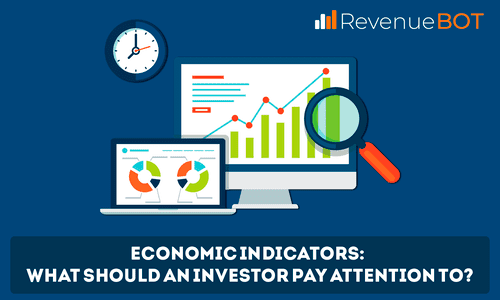
In this material, we decided to step away from the industry crypto and talk about the most important economic indicators that help understand the world economy. Not many, but each one of them has very important information for every investor.
GDP
The Gross Domestic Product or GDP is the most important economic indicator that displays the quantity of goods and services produced in a country for the past quarter or year. There’s also a global GDP that represents the same thing, just for the world. In addition to GDP, there is GNP, the gross national product, which reflects the production of national enterprises, regardless of their location.
GDP is considered the most important macroeconomic indicator because it reflects the economic reality of a country or the world. In each country, GDP is calculated in the national currency, but in order to publish the results for the whole world, they are converted into United States dollars on the basis of the exchange rate. The results of GDP are not as important as they were in the previous quarter or year. Let’s say, published the results of GDP of Russia for 2020 -1.4%. This means that Russian GDP decreased by -1.4% compared to the previous year.
There is also the term «GDP per capita». GDP per capita should reflect the economic condition of a country relative to its citizens. To put it bluntly, how good we are to live here. In fact, this indicator is not often used, because it does not use the same population groups, so its results are not effective.
The GDP indicator influences the exchange rate of the national currency: if it is lower than last year, the rate drops, if it is higher, the rate rises. With rising GDP, foreign investors are eager to invest in the country’s enterprises, thus strengthening the currency. The opposite is true if GDP does not grow or fall. There is one point in calculating GDP – some countries artificially inflate gross domestic product to attract more investment.
CPI
CPI (Consumer Price Index) is an index of each country that measures changes in the prices of goods and services over a period of time. The indicator is used by investors quite often because it helps to understand whether there is inflation or deflation in a country. As with GDP, the results of the consumer price index are compared to the previous one and measure how bad the situation is.
The consumer price index is interpreted as follows: if the result is more than 100%, this means that the cost of goods and services in a country has increased. If the result is less than 100%, then the cost is reduced. The basic goods and services for measuring the consumer price index are different for each country: in the less developed countries, most goods are food. And say, in France, wine is added to the consumer basket. The bulk of the consumer basket consists of prices for food, medicine, housing, transportation and other activities, without which the average citizen cannot live.
As already mentioned, the consumer price index measures whether a country has inflation or deflation. With a score above 100% the national currency is running through, which is a clear hint of inflation. But do not think that if the rate is less than 100%, that is great: for example, in Japan, Switzerland, the US, and other advanced countries, there is no inflation, but there is deflation. The name suggests that this is the opposite of inflation – the national currency is expensive. Because of this, the cost of goods and services is constantly falling, forcing buyers to spend less on what they can do without: transportation, real estate, leisure, etc. People realize that if they wait any longer, the prices for the things they need will get even lower. The same reason is responsible for the outflow of funds from local banks: Why would you send your money somewhere if you’re growing purchasing power? Local companies, calling it «business process optimization», lay off workers because there is no demand for goods and services and wages have to be paid.
Unemployment rate
It is clear from the name that this indicator refers to the unemployed in a country. The unemployment rate, by importance, follows immediately after GDP and is published quarterly and annually. About 80 percent of the workers who contribute to the gross domestic product are included in the calculation of the unemployment rate. Each country publishes its unemployment rate for a year or a quarter, but the biggest impact on the market is in the US.
As in the case of GDP and the consumer price index, unemployment rates are commonly compared with previous rates. If the figure is lower than the previous one, it is as follows: the number of unemployed in the territory of the country has decreased, output in various enterprises has increased, exports have increased, retail sales have increased and savings for people have increased. If the rate has risen, the opposite is true.
As noted above, the US unemployment rate is having a significant impact on the stock market. With low unemployment, company shares are rising, because people have savings and are willing to invest. With high unemployment, stock prices fall, because people only have money to live on. In addition, if there has been a significant increase in the number of unemployed persons in a year, this may signal an impending financial crisis: for example, at the end of 2007 the unemployment rate in the US increased by 5%, and in 2008 the mortgage crisis began.
